In the 19th century the voyage to Australia was long and arduous. Emigrants faced the constant threat of disease and malnutrition, the danger of storms or shipwrecks, and the possibility of piracy or crew mutiny.
One ship that had a particularly perilous journey was the HMS Hercules, which departed Campbelltown, Scotland in December 1852 carrying Scottish Highlander emigrants and arrived in Melbourne August 1853 – 8 months later!
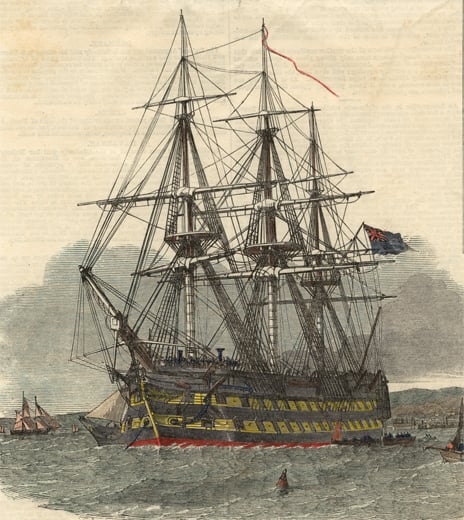
In the 1850s over 90,000 Scots emigrated to Australia, 30,000 as assisted immigrants. [1] Many came from the Highlands, where the collapse of the economy, the eviction or clearance of tenants by the Highland landlords and the Potato Famine had left thousands without work and close to starvation.
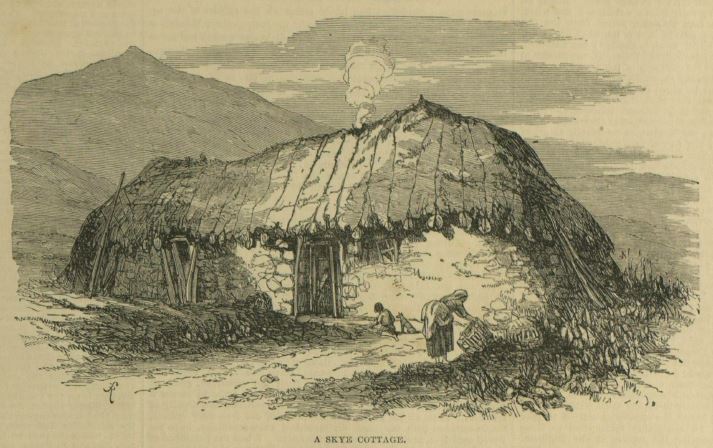
A number of government and privately funded emigration schemes were established to encourage people to migrate overseas. One such scheme, the Highland and Island Emigration Society (HIES) believed that by relocating families to Australia –
`they who are a burden to the British community in the mother-country, will become a support to it when they have been transferred to the colonies’…`they will exchange a life of demoralising dependence for one which will abound with the rewards of industry and enterprise’. [2]
Between 1852 and 1857 nearly 5000 Highlanders were relocated to Australia by the HIES. Preference was given to the most destitute, to entire family groups and to those with relevant skills, such as agricultural labourers, shepherds, carpenters, and farm and domestic servants.

The HIES ships were chartered by “Her Majesty’s Colonial Land and Emigration Commissioners” who offered the Hercules at a reduced rate. The ship was intended to be used as a floating hospital for troops in Hong Kong, but would first be used to convey the emigrants to Australia. The Commissioners also reduced the deposits of the emigrants by 50%.
“Married persons and unmarried women will be 10s., instead of £1; of children 5s. instead of 10s.; of single men, members of emigrant families, £l instead of £2; of persons between 45 and 50 years of age £2 10s. instead of £5; and of persons upwards of 50, £5 10s. instead of £11″.[3]
Clothing and funds were provided by the society with each family agreeing to pay back the full amount within 12 months. The HIES passenger lists include promissory notes detailing the amount owed. The lists also contain revealing comments regarding the health and circumstances of each family group.
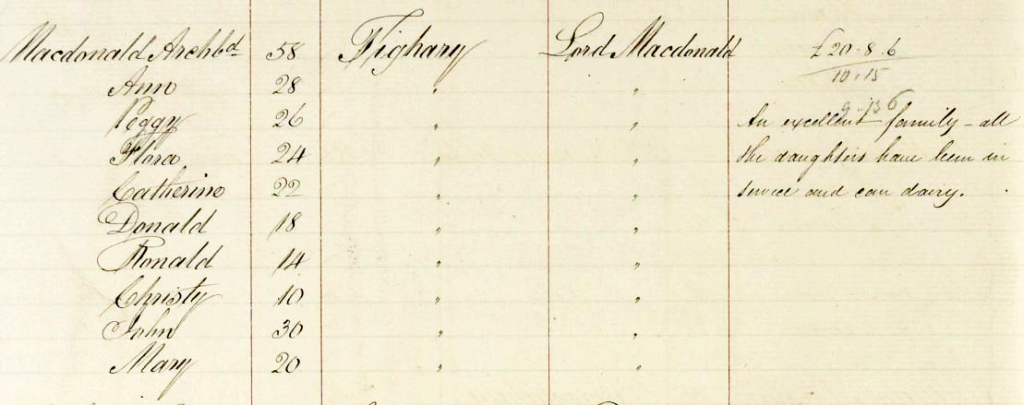
Entry for Archibald MacDonald and his family. [4]
In December 1852 emigrants were transported from Skye, Harris and North Uist in the Outer Hebrides to Campbelltown, where they boarded the Hercules. They spoke no English, were poorly clothed, and many were malnourished from years of living in poverty. James Chant, the HIES emigrant officer, wrote of their despair at leaving their homeland –
“The leave taking was the most painful scene I ever witnessed. Sturdy Highlanders grasped each other by the hand, while the muscles of their faces and bodies quivered with emotion. Women hung on the necks of their friends, and were in some cases removed by force. To say they sobbed aloud, would faintly express their sorrow… they threw their arms into the air, giving full vent to their grief, as they gazed for the last time on the black peaty glen and bleak rocky hills, over which they had long been accustomed to roam and to which they were so devotedly attached.” [5]

The Hercules departed on December 26 1852, carrying 756 passengers, and sailed for four days through a fierce storm, before anchoring in Rothesay to make repairs. Passengers had been confined below deck during the journey, and many were extremely distressed and unwell. Two men died of sickness. On December 30, Captain Baynton wrote –
“We have a case of fever, and another of small pox and measles on board, but I have no doubt that by the judicious arrangements of Mr Carey (the Ships surgeon) and his assistant, we shall prevent it’s spreading”. [5]
Two weeks later the Hercules set sail and hit another severe storm. She docked in Queenstown, County of Cork, Ireland on January 20, by which stage over 50 cases of Small Pox and an outbreak of Typhus fever was discovered. Fifteen of the crew were taken to the naval hospital on Haulbowline island, but an attempt to land the passengers in Queenstown was met with opposition by the townsfolk, the health officers and the Irish government.
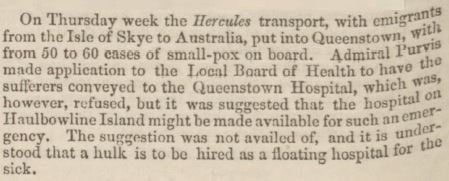
Discussion raged for several weeks, by which time several hundred passengers were infected.
The Cork Examiner wrote a damning article stating that this was –
`A revolting instance of the barbarous and cruel folly of our quarantine laws’ and referred to the Hercules as…`a prison of death’.
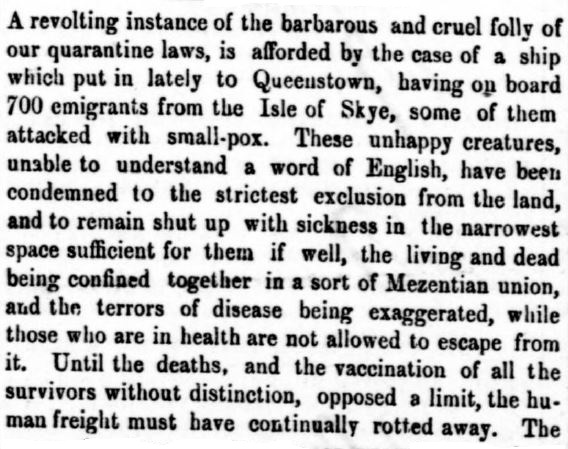
Eventually, a hulk was brought to the harbour where it acted as a floating hospital for the fever patients. Small pox patients were housed in the hospital on Haulbowline Island, where a large shed was erected to house healthy passengers.
The ship remained in quarantine for three months, during which time 56 people died, including Laurence Carey the ship’s doctor, and Mrs. Innes the matron. Seventeen children were orphaned and returned to Scotland. The Cork Examiner stated that the case of the ship Hercules was “without precedent in the history of official mismanagement and neglect”. [6]

On April 14th, the Hercules finally set sail for Australia, carrying only 380 of the original 756 passengers. The remainder of the passengers were relocated to other emigrant ships – in many cases families were separated, never to see each other again.
From all accounts. the voyage to Australia was fairly uneventful. She docked in Adelaide on the 20th July, leaving 194 emigrants, and finally arrived in Melbourne on 3rd August, where 183 disembarked. Having survived this long and perilous voyage and finally setting foot on Australian soil, one might wonder where their journey would next take them.
References
1. Prentis, M. (2008). The Scots in Australia. Sydney: University of New South Wales Press 2008. Also available online to registered members of the State Library Victoria.
2. Victoria. Parliament. Legislative Council (1852). Emigration from the Highlands and Islands of Scotland to Australia : ordered by the Council to be printed, 29th December, 1852. Printed by John Ferres, at the Government Printing Office, [Melbourne].
3. Emigrants by the Hercules. (1853, March 24). The Courier, p. 3. Retrieved August 5, 2020, from http://nla.gov.au/nla.news-article2241259
4. ScotlandsPeople. Hercules passenger list. Retrieved from Highland and Island Emigration Society records.
5. McNeill, John, Great Britain Colonial Land Emigration Commission, British Library, and Adam Matthew Digital. Correspondence Relating to Her Majesty’s Emigrant Ship “Hercules” [electronic Resource]. London: F. and J. Rivington, 1853, in the Migration to New Worlds database.
6. “News.” ( 1853, Feb. 18). Cork Examiner, p. 2, from British Library Newspapers database.
Further reading
Haines, R. (1997). Emigration and the labouring poor : Australian recruitment in Britain and Ireland, 1831-60. New York St. Martin’s Press.
Highlands and Islands Emigration Society records. Scottish Archive Network – Virtual vault.
Highland Island Emigration Society. (2000). [List of Emigrants Assisted to Australia by the Highland and Island Emigration Society], 1852-1857 [manuscript].
List of persons who have received loans of money from the Island and Highland Emigration Society to enable them to emigrate from their native country to Victoria. (1854). [Melbourne]
Richards, Eric (1978). The Highland Scots of South Australia. A paper presented to a meeting of the Clan MacLeod Society in South Australia.
ScotlandsPeople. Highland and Island Emigration Society records.
Wilkie, B. (2017). The Scots in Australia, 1788-1938. Woodbridge, Suffolk.


What an interesting and sad story. Thanks for telling the tale.
Thanks Andrew. Unfortunately many ships had similar experiences and it was quite common to have outbreaks of disease.If you’re interested, there’s a great book called Hell ship by Michael Veitch, which look at the journey of the Ticonderoga in 1952. Interestingly that ship also carried many Scottish Highlanders! Regards Ann
A knock-out article. Oh, how much Melbourne owes these first immigrants. And we think we’re doing it tough today.
Indeed: “Having survived this long and perilous voyage and finally setting foot on Australian soil, one might wonder where their journey would next take them.”
What a fabulous sentence. Worth reading twice. Thanks.
Thanks so much Al, I’m glad you enjoyed it. You’re absolutely right, the emigrants who travelled here in the 19th century really were courageous and displayed great fortitude. Their stories are well worth telling. Regards Ann
Thank you Ann for providing another layer to my understanding of what was experienced by my great, great grandparents, highlanders from Ross Shire. They were passengers aboard the John Davies which left Liverpool on 23 July 1852 and arrived at Portland on 8 November, settling in the Hamilton area.
Hi Peter. That’s so interesting. I first heard about the Hercules when helping a researcher trace her Scottish ancestors, who settled in Hexham – not too far from Hamilton. I’m glad the story was of interest to you.Regards Ann.
Hi Ann. My name is Criosdean and I am from North Uist in the Outer Hebrides. I wanted to thank you for writing about HMS Hercules and its voyage to Australia with Scottish Emigrants in 1852. Many of my ancestors (who were ‘cleared’) left on that fateful voyage and disembarked in Adelaide, SA. I co-run a Facebook page which follows their story from leaving their beloved islands up until their final resting place at the White Hut Gaelic Cemetery in Clare, South Australia. I was fortunate enough to visit it in 2018 and my host (who also co-runs the FB page) and lives in Australia has ancestors buried there as well. We feels that it’s important to share their story with others across the seas who may not have the opportunity to visit and we also want to keep their memory alive. If anyone would like further information I have copied the link: https://www.facebook.com/FriendsofTheWhiteHutGaelicCemetery/
Hi Criosdean, thank you so much for your comments and for the Facebook link. It’s a great way for researchers to share their stories and research findings. Whilst researching the Hercules I came across this very informative article by Eric Richards, called The Highland Scots of South Australia. You might have already seen it. Eric Richards wrote many other excellent books and articles about the Highland Clearances and Scottish emigrants – they’re really worth tracking down. All the best, Ann
Thanks Chris for finding this and thank you Ann for the link to Eric Richards PDF.
Tania … Adelaide
You’re very welcome Tania. Regards, Ann.
Hi.
Today I learned that my ancestors, Murdoch and Mary Macdonald with their three children, cam to Australia on the Hercules in 1852/3. They came from North Uist.
I’m trying to find out more about the voyage of the Hercules.
Any guidance would be great appreciated.
Best regards,
Jim Griffin
Hi Jim, thanks so much for your query. We have a book in our collection on the Hercules. Here are the details – H.M.S. “Hercules”, Scottish emigrant ship 1853.by W. B Clarke (William Bartlett), Bicheno, Tas. : W.B. Clarke 1999. Talk to staff in your local public library, as you may be able to order this item on inter library loan. There are a number of excellent websites relating to the Hercules. If you go to the Wikitree page Voyage of the HMS Hercules to the South Australian and Victorian Colonies in 1853 you will find a detailed bibliography of online resources regarding the Hercules. If you live in Australia it’s worth joining the State Library for the state in which you live. Membership would allow you to access a range of online UK historic newspapers from home – where you will be able to find various articles on the journey. Also, if you’re interested, there’s a Facebook page called Friends of the White Hut Gaelic Cemetery. Many of the Scottish families who sailed to Australia from the Highlands and Islands, are buried in this cemetery, and there are often posts about the Hercules and the HIES scheme on this site.Kind regards Ann
Hi Ann,
Thank you for writing about the Hercules. My ancestors – McBain – were among those who embarked that fateful voyage on 26 December, 1852. The depth of sorrow in leaving their homes and the land of their ancestors is something I can scarcely imagine.
I’m currently researching the Hercules voyage, and the McBain story, as part of my study in Dip. Family History with UTAS. Your references and links have proved very helpful.
Sadly the McBain family lost at least 2 members during the voyage, and became separated.
I do have one query. Due to famine and the highland clearances, is it safe to assume all migrant families onboard the Hercules had little choice but to emigrate?
Kind regards,
Tess
Hi Tess, thank you for your query. Yes, I think you are right in assuming that the families who were sponsored by the Highland and Island Emigration Scheme, primarily saw immigration to Australia as a chance to escape the poverty of the Highlands. Like other 19th century migrants, they would also have seen Australia as a `land of opportunity’, where they would find work and prosper. The following publication may help you with your research “The Scots in Australia – A Study of New South Wales, Victoria and Queensland, 1788-1900. If you are a Victorian resident you can join the State Library Victoria and access this ebook from home. If you live interstate, check to see if your State Library holds a copy. Good luck with your research. The Diploma of Family History is a great course! Kind regards, Ann
My gg grandparents Alexander and Rachel McInnes from Heaste on the isle of Skye left Campbelltown on the Hercules .In Queenstown my g grandfather Duncan McInnes was diagnosed with a mild case of Variola and his cousin Margaret McInnes who was travelling with them jumped overboard and drowned ,they completed their voyage on the David Malcom and landed in South Australia roughly a year after they st sail from Scotland . Rachel died a decade after they landed , Alexander married again and had more children last one when he was eighty . One day one of Duncan’s younger sons said to his mother I’d like to ask my dad about the voyage our to Australia , she said don’t, in all the time I’ve known him he has refused to talk about that time in his life must have been traumatic
Dear Huw, thank you so much for sharing your ancestors story. It’s hard to imagine what they went through – as you said, it must have been so traumatic. I remember reading about the sad fate of Margaret McInnes when researching this blog. Many articles were written about the voyage of the Hercules in 19th century UK newspapers. If you live in Victoria you can access a number of historic newspaper databases through the State Library. You can get library membership here. If you live interstate, check with your own State Library, as they provide access to similar databases. Kind regards, Ann
Hi Ann Thank you so much for sharing your ancestors story what a harrowing trip. My 3 x Great Grandmother was initially on the Hercules, her husband Lachlan McBain died in Queenstown. She completed the voyage to Adelaide on the ‘Neptune’ had a baby girl on the voyage and remarried in Adelaide and went onto live in New Zealand. I am descended from her second husband William McPherson. The oldest daughter Janet.is my 2 x great grandmother and was born at Port Adelaide. I was wanting to find out a bit more about the conditions in the Outer Hebribes at the time that they left. Also a list of passengers who died while at Queenstown, County Cork. I am starting my Dip. of Family history as UTAS next semester as a remote student. If I join the state library should I do it as a student or just the normal access.
Kind regards
Julie
Hi Julie, Many of the documents on the HIES scheme are freely available from home. Historic newspapers will be really useful for information on the Outer Hebrides and there should also be many books available on the Highland Clearances in the 19th century. To join the State Library Victoria and access our online newspapers from home, you do need to be a Victorian resident. The normal Access membership is suitable for your requirements. If you happen to live interstate you can join the State Library for the State where you live and access similar newspaper databases. The UTAS Diploma is a great course. I hope you enjoy it and manage to find some interesting information on your ancestors. Kind regards Ann
Dear Ann,
Absolutely thrilled with the story of the Hercules.
I find out that I am related to Julie Johnson.
June Hallett.
Hi June, Thanks so much for your message. I have sent you an email but could you please check your junk mail, just in case it didn’t get through. Kind regards Ann
My great great grandparents and their children came from Harris and remarakably all survived the fateful voyage of the Herucles.
I feel quite humbled to read of this journey, previously unknown in our family tree.
Thank you so much for sharing your story Lis. I’m so pleased that this blog helped you discover more about their incredible journey to Australia. Kind regards, Ann.
Ann Copeland: I read your article on the ship Hercules, and wondered if you could help me in some research links. I have a Hercules (1802) ships bell, which ended up on the Miramichi area of New Brunswick (province) in Canada, eventually coming into our family hands. I have several late 1700s to early 1800s MacDonald, as well as MacLean, Murdoch, and Taylor ancestors, including Macleans from Isle of Eigg for whom seamenship was almost hereditary. How it ended up in our area I don’t know, and whether from wreckage of a commercial or military ship I have no knowledge. By size / weight it would appear to be from a ship in the 100s of tons. I hope for it to go to a museum in New Brunswick, ideally on the Miramichi where I grew up.
Hi David Thank you for your query. There appears to have been numerous ships called the Hercules which sailed over the last 300 years. For advice regarding possible shipwrecks and the history of ships in your area, I recommend that you contact the Maritime Museum of the Atlantic based in Nova Scotia. On their Research page you can find information on research associates who can undertake research for members of the public and also details on their reference library. I hope this helps you with your research query. Kind regards Ann
Hi Ann.
A great packaging (both written & YouTube) of the sad tale of most disastrous of the HIES migration voyages. It seems that HIES never again undertook direct charter of a vessel, but worked through supplying passengers to shipping agents. Sometimes they only contributed a few passengers, but in other cases a full complement.
Feedback on two items:
* ‘Campbeltown’ (located near the Mull of Kintyre) is spelt with just one ‘L’ (despite being named after the Campbell laird). I visited it in May, and it was hard to imagine a ship the size of the ‘Hercules’ in a harbour where the largest boat now is a fishing trawler.
* From my research it appears that while the HIES assembled and facilitated emigration of ‘destitute’ families, it seems that the full passage fares of HIES passengers were met by the government of the Colony of Victoria, paid to ship owners/agents upon the delivery of live ‘souls’. I have found this to be the case with most of my migrant ancestors (largely migrating during the 1850s). [A similar scheme was being used by the NSW colonial government in the 1840s (prior to the goldrush and Victoria’s separation).] Calculations tallying the sum for payment to the shipping company can frequently be found written on ship passenger lists accessible through PROV – a nineteeth century application of outsourcing to private contractors! Perhaps the landlords and agencies (Scottish and in Whitehall) that comprised HIES assisted in transport costs to embarkation ports, or maybe landlords waived rent arrears that had accumulated into large amounts as crofters were unable to generate sufficient income to pay rent being asked by the landlords. This was more subtle than forced evictions and burning houses.
The ‘deposit’ mentioned for passengers would be forfeited to discourage no-shows, but entitled passengers to a kit of bedding, plates, utensils, etc that they retained at the end of their passage. This might also have been paid by those keen to ‘export surplus population, particularly destitute families’.
Squeezing into an Economy seat for a 24 hour flight needs to be put into perspective compared to 100-odd days with a family sharing a slightly larger space below decks.
Thanks for this informative article,
– Rod
Hi Rod. Thanks so much for your comments. The information regarding the fares is particularly interesting – and useful! All the best, Ann
Thank you so very much for writing this article.
My ancestors were on board this voyage
They were Neil and Flora Mackinnon of Teangue, Skye who travelled with their 3 children and settled in Yass, NSW. Flora – daughter of Lachlan McKinnon and Mary McInnes.
Thank you
Dear Liz, Thanks so much for your kind words. I love the fact that the story of the Hercules and the families who travelled on it, still lives on. And that there are so many people who are interested in their stories. All the best, Ann